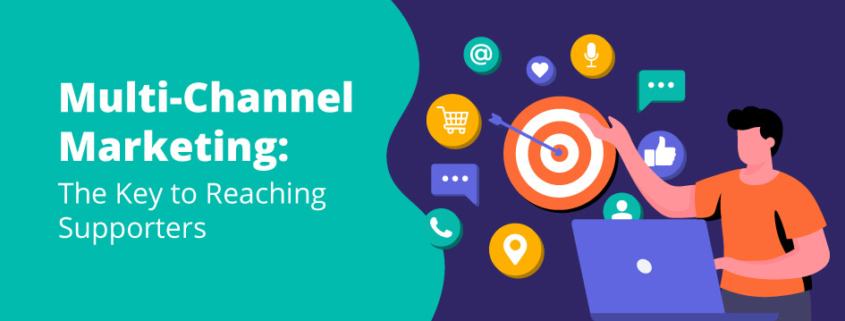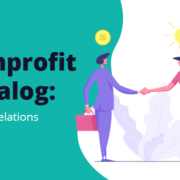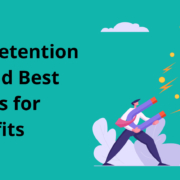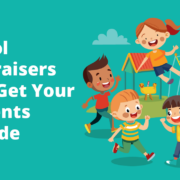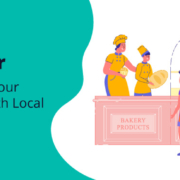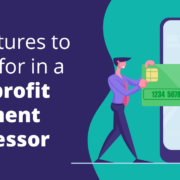Multi-Channel Marketing: The Key to Reaching Supporters
Marketing research indicates that it can take up to 50 touchpoints to make a sale. A few factors influence the exact number of interactions needed, such as industry and where the individual is in their journey. Regardless, this fact points to one major takeaway: multi-channel marketing is essential for driving action.
This holds true in both the for- and nonprofit sectors, meaning your nonprofit needs to connect with supporters repeatedly to inspire support. Multi-channel marketing, the act of contacting supporters across multiple platforms, is often the key to acquiring new donors, volunteers, and advocates. It also spreads awareness of your services and programs to beneficiaries.
To strengthen and diversify your nonprofit’s outreach strategy, we’ll explore why multi-channel marketing works and how your team can use it.
What is multi-channel marketing?
Multi-channel marketing is a strategy that involves communicating with supporters across multiple platforms, such as email, direct mail, and social media. This approach ensures messages reach supporters where they are active and increases the number of times they see your communications.
For example, perhaps your nonprofit is promoting matching gifts. You start by creating a dedicated webpage explaining the program and its impact. To maximize reach, you repurpose that content into a compelling Facebook post, include a mention in a fundraising letter, and send a brief but impactful text message reminder.
For nonprofits, multi-channel marketing builds donor trust and cultivates stronger relationships by providing consistent messaging across various touchpoints. It leverages the strengths of different channels—such as the personal touch of direct mail, the immediacy of social media, and the storytelling power of email—to create a unified donor outreach strategy.
Omni-Channel vs. Multi-Channel Nonprofit Marketing
Multi-channel marketing is related to omni-channel marketing. With multi-channel marketing, you reformat the same message for multiple platforms. With nonprofit omni-channel marketing, each message builds on the one that came before it, integrating multiple channels to create consistent experiences for supporters.
Omni-channel marketing is a more personalized strategy designed to guide supporters through their giving journey. For example, your nonprofit might send a direct mail donation request, thank the donor with an emailed eCard, and then text the donor an invitation to follow you on social media.
Both strategies are valuable and should build upon one another to maximize impact. Start with multi-channel marketing to attract new supporters, learn the basics of communicating via multiple channels, and discover which tactics work best. Then, transition to an omni-channel approach to nurture relationships and encourage long-term giving.
Why does multi-channel marketing matter?
Your supporters don’t all engage with content the same way. Some prefer email, others scroll through social media, and some respond best to direct mail or phone calls. Multi-channel marketing helps you meet supporters on the platforms they actively use.
Instead of relying on a single outreach method, use multi-channel marketing to:
- Expand your reach. The more platforms your nonprofit markets on, the more prospective supporters will see your content.
- Build brand recognition. Repeated exposure builds familiarity. When supporters consider which nonprofits to give to, they’ll likely gravitate toward organizations they’ve already heard of. By getting your nonprofit’s name and mission in front of the same supporters repeatedly, they’ll come to know and trust your organization.
- Improve conversion rates. Each touchpoint pushes supporters toward giving. A donor might ignore your first email, but a follow-up text or social media post can prompt them to give. Providing multiple touchpoints ensures supporters can respond in the most convenient way.
Whether you’re soliciting donations or looking for extra volunteers, diversifying your outreach will keep your cause top of mind for current and potential supporters. Consistency will ensure your message reaches the right people at the right time.
Essential Platforms for A Nonprofit Multi-Channel Marketing Strategy
Your nonprofit will need to find a unique combination of platforms that drives results. Select your outreach methods based on what channels your audience uses and how confident your nonprofit is in its ability to maintain an active presence.
Let’s explore a few popular channels.
Email is a powerful channel for driving donations, sharing project updates, and educating supporters about your mission. In 2023, nonprofits experienced a 7% growth in their email subscriber lists. This growth positions email as a reliable channel to deepen your nonprofit’s connection with its audience.
You can enhance your email strategy by:
- Improving subject lines. Subject lines determine whether an email gets opened. Aim for 50 characters or fewer to avoid getting cut off. Use urgency, curiosity, or personalization to elicit an emotional response and boost your open rates (e.g., “You Can Change a Life Today”).
- Issuing just one call to action (CTA). Emails that ask donors to take multiple actions, like donating, volunteering, and subscribing to your newsletter, may confuse recipients.
- Varying the content you send. eCardWidget’s donor retention guide recommends sending donation appeals, personalized thank-yous, impact stories, and mission updates to keep donors engaged. Switch up the format by using letters, monthly newsletters, and digital greeting cards.
Even with these strategies, your emails will only be effective if delivered successfully. If your emails have a high bounce rate, your subscriber list is likely outdated. Use an email append service provider to fill in missing emails and correct defunct ones. In turn, supporters will receive your focused, inspiring emails.
Social Media
Many supporters likely use social media. Focus on the platforms where they’re most active. For inspiration, here’s how to incorporate social media into your nonprofit’s multi-channel marketing strategy:
- Facebook. Facebook commands a massive audience. While advertising isn’t discounted for nonprofits, Facebook’s audience targeting tools allow you to direct ads to high-value prospects. For organic posts, focus on compelling storytelling, high-quality visuals, and mission-related news stories.
- Instagram. An Instagram account can be impactful if your nonprofit’s mission lends itself to eye-catching photographs. For example, the animal shelter Perry’s Place went viral for its “Naughty & Nice Cat of the Week” marketing campaign.
- X (Formerly Twitter). Share timely updates, post about relevant trending topics, and engage via replies and shares. Additionally, keep an eye out for upcoming competitors like Threads and Bluesky.
- TikTok. Nonprofits have flocked to TikTok in the past few years. However, the future of TikTok in the United States is unclear due to recent legislation. If your nonprofit decides to pursue a TikTok strategy, consider signing up for TikTok for Good, which provides nonprofits with free marketing tools like donation stickers and fundraising livestreams.
When it comes to social media, only create accounts if you know your organization will be able to maintain them. Abandoned accounts can make supporters question your organization’s health.
Nonprofit Website
Your nonprofit’s website is an essential marketing tool. It serves as the central hub for information, tells your organization’s story, and enables supporters to donate or sign up for opportunities.
To create an inspiring website, follow these best practices:
- Communicate your work. Feature an ‘About’ page, create individual program pages, post case studies, and write blog posts about your mission. Show the difference your nonprofit is making.
- Feature compelling visuals. Use high-quality images and videos that showcase your nonprofit’s impact. Photos of beneficiaries and volunteers create emotional connections, infographics simplify data, and videos tell inspiring stories.
- Include trust signals. Showcase impact metrics, testimonials, and reports to build credibility and reinforce donor confidence.
- Make it easy to navigate. Feature important pages in your website’s navigation menu. Include strong CTAs across key pages to guide visitors toward donating, volunteering, and getting involved.
To improve your website’s discoverability, optimize its content for search engines. That means using relevant keywords in each page’s copy, meta description, and headings. An effective SEO strategy also involves ensuring your site loads quickly and is mobile-friendly. In turn, your site should show up to supporters and beneficiaries looking for nonprofits like yours.
Search Ads
Google processes more than 8.5 billion searches every day. This means the search engine has a massive audience that nonprofits can tap into with search ads. These ads appear at the top of search results for websites related to the user’s query.
For example, here’s a search ad for a nonprofit that explains the organization’s mission to combat adolescent depression. The ad promotes multiple landing pages for learning more and getting involved:
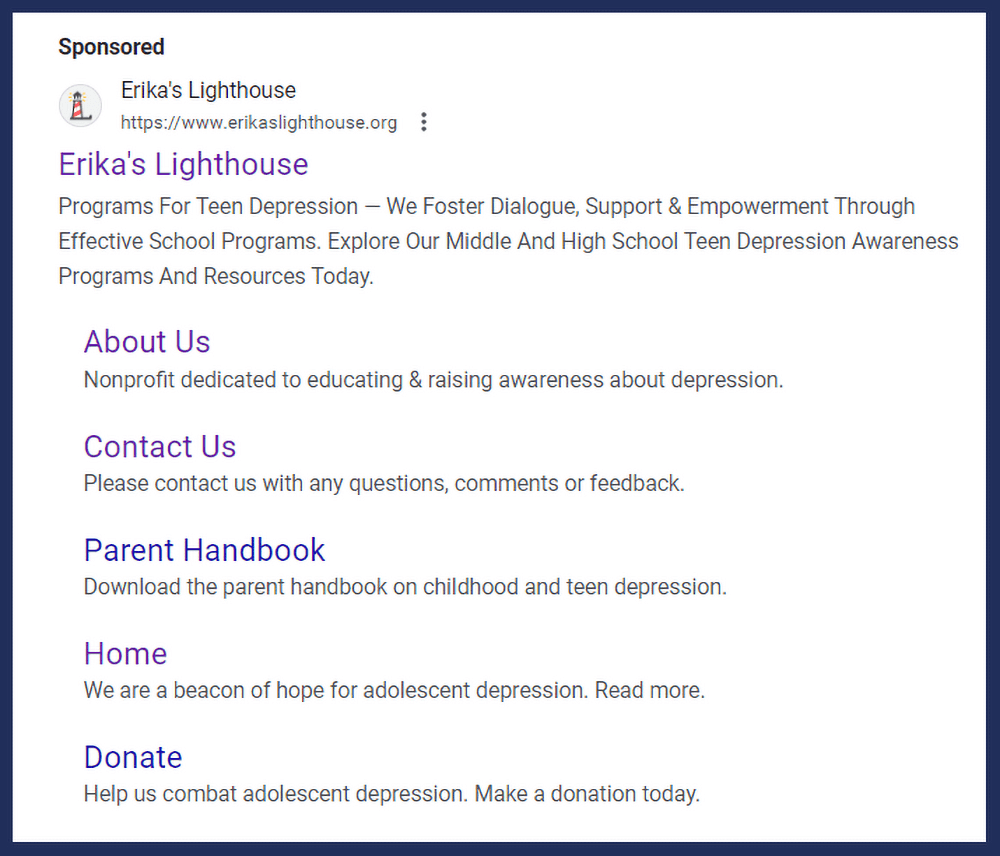
Paid advertisements can get expensive quickly, but fortunately, Google provides nonprofits with credits to spend on search ads. The Google Ad Grants program provides up to $10,000 in ad credits per month to approved charitable organizations. Participants can use their grant money to bid on mission-related keywords and promote specific pages on their websites through text-based ads.
Your nonprofit might promote its:
- Donation page to encourage financial contributions to your mission
- Volunteer opportunities to recruit people to help out
- Fundraising events to encourage registrations
- Educational content that shares valuable insights and mission updates
- Program pages to inform people about your services
Essentially, your nonprofit can promote any content that will push its mission forward. If your organization complies with the program’s rules, the grant will renew each month.
Text Message
Text messages connect you with your audience almost immediately, making them effective for quick updates and urgent messages. While text messaging can be a powerful part of your multi-channel marketing strategy, it’s also easy to overuse.
Many people keep their phones within arm’s reach, meaning they will likely see your nonprofit’s messages quickly. While this is convenient for getting your message seen, it also means supporters will be aware of how often you message them. During busy times of the year for marketing, like the end of the year or during election season, it’s easy for supporters to get overwhelmed with text messages.
To retain donors, use text messages sparingly and only when an immediate alert to your audience is appropriate. You might use it to announce an upcoming event, send urgent appeals, remind volunteers about upcoming shifts, encourage donations throughout a campaign, or send donation receipts.
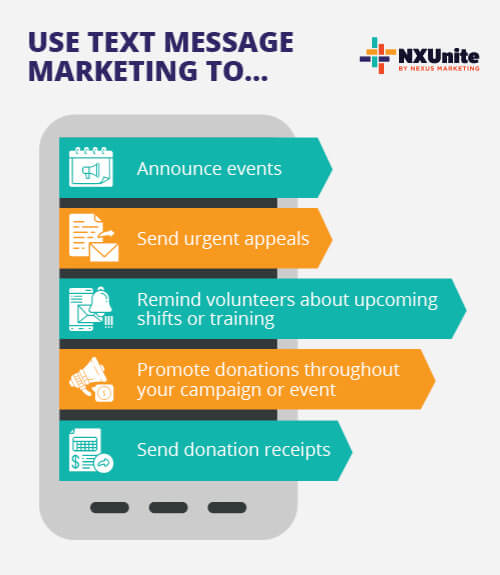
Direct Mail
While much of modern nonprofit communication is digital, there’s still a place for direct mail. Receiving a letter in the mail can make recipients feel special and help your nonprofit stand out.
To build brand recognition, ensure your direct mail communication has the same branding as your online marketing materials. This creates a consistent experience across platforms and presents your nonprofit as a capable, professional organization.
Allegiance Group + Pursuant’s direct mail fundraising guide provides an excellent example of a direct mail insert donors can use to send donations to the Georgia Mountain Food Bank:
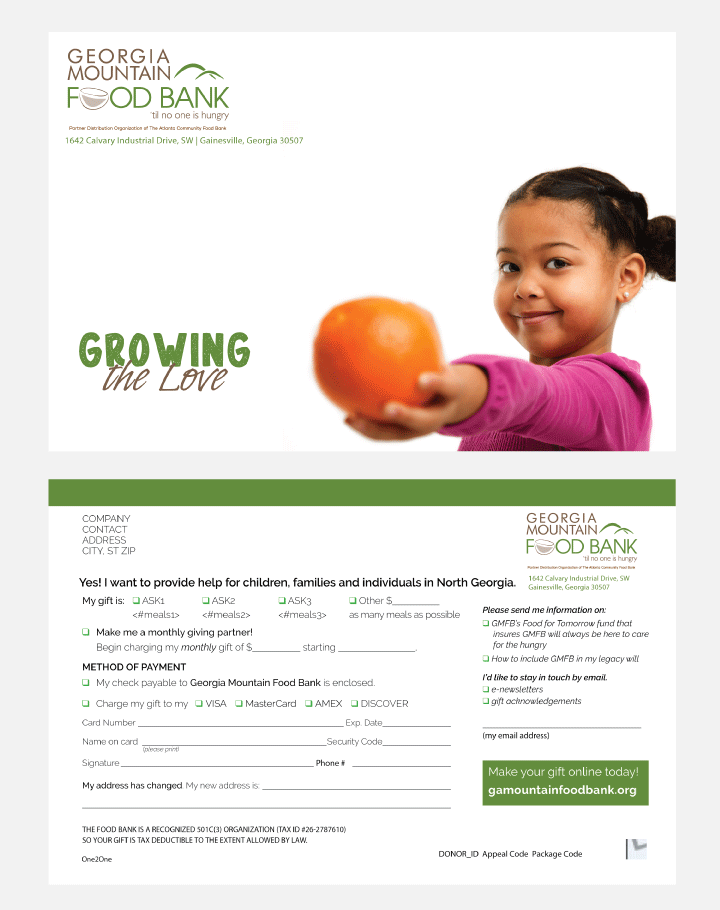
Notice how it features the organization’s colors and an eye-catching image of a child, representing the families the food bank serves. The nonprofit makes it easy to select an amount and provide payment information with clearly labeled boxes. Alternatively, the nonprofit’s website URL is featured in a box, providing the option to give online.
To emulate their approach, start by creating a nonprofit style guide that includes guidelines for direct mail. This might include directions for font sizes, letterheads, and signatures.
Launch Your Nonprofit’s Multi-Channel Marketing Strategy.
By sharing your nonprofit’s messages on multiple channels, your organization can reach new supporters and reinforce your brand identity among current ones. Choose which channels you’ll expand to by assessing your audience’s interests, your nonprofit’s resources, and each platform’s outreach potential. In no time, you’ll strengthen your presence across both online and offline channels.
